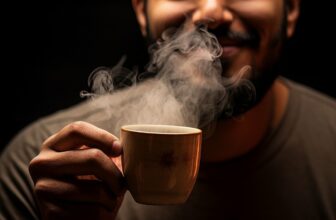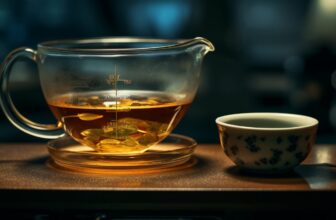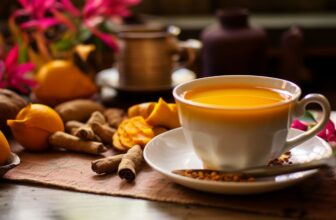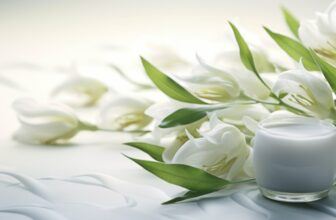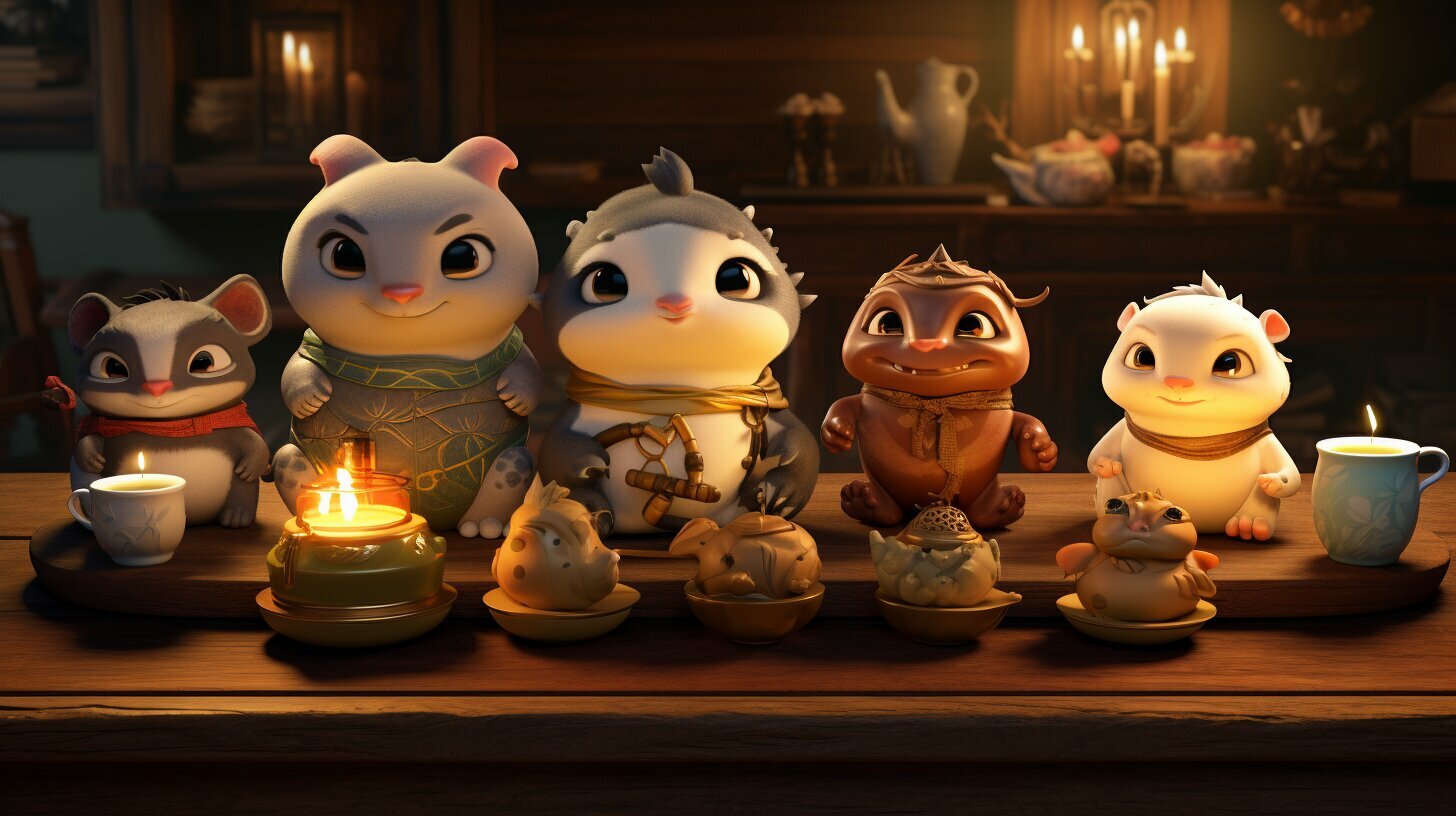
Tea pets are fascinating ceramic figurines or ornaments that add a touch of magic and companionship to your tea brewing rituals. Made from glazed or unglazed ceramic, including Yixing clay, these small treasures have a unique role in tea culture. As you pour tea over a tea pet, its surface absorbs the tea and undergoes a color change, making every brewing session truly enchanting.
Key Takeaways:
- Tea pets are ceramic figurines or ornaments used in tea ceremonies, enhancing the tea-drinking experience.
- They are made from glazed or unglazed ceramic, including the famous Yixing clay.
- Pouring tea over a tea pet allows its surface to absorb the tea and change color, adding an element of magic.
- Tea pets serve multiple purposes, such as companionship, luck-bringing, and home decoration.
- Traditional Chinese tea pets include the Pee Pee Boy, Three-Legged Golden Toad, Qilin, Buddha, Pig, Tiger, Elephant, Bai Cai, Pixiu, and Turtle.
The Enchanting History of Tea Pets
Tea pets have a captivating history that can be traced back to ancient times, with their popularity reaching new heights during the Ming and Qing Dynasties. These small ceramic figurines or ornaments are an integral part of tea culture, adding charm and symbolism to the tea-drinking experience. Made from glazed or unglazed ceramic, including Yixing clay, tea pets come in various shapes and sizes, each with its own unique story to tell.
The origins of tea pets can be traced back to the Ming Dynasty, where they first emerged as companions for tea drinkers. These adorable figurines were believed to bring good luck and enhance the enjoyment of tea. During the Qing Dynasty, tea pets became even more popular, with a wide range of designs inspired by animals, mythical creatures, and religious symbols.
The enchanting history of tea pets is deeply intertwined with the traditions and rituals of Chinese tea ceremonies. Tea lovers would pour tea over the tea pets, allowing the surface to absorb the tea and change color over time. This gradual transformation not only added to the visual appeal of the tea pets but also created a connection between the tea drinker and the figurines.
The Evolution of Tea Pet Designs
Over the centuries, tea pet designs have evolved to reflect the changing tastes and preferences of tea enthusiasts. Traditional Chinese tea pets include the Pee Pee Boy, Three-Legged Golden Toad, Qilin, Buddha, Pig, Tiger, Elephant, Bai Cai (Chinese Cabbage), Pixiu, and Turtle. Each of these tea pets carries its own symbolism and meaning, enhancing the cultural significance of tea ceremonies.
The Pee Pee Boy, for example, is a symbol of good luck and prosperity, while the Three-Legged Golden Toad is associated with wealth and financial success. The Qilin represents benevolence and good fortune, and the Buddha embodies peace and enlightenment. These tea pets not only serve as decorative pieces but also infuse the tea-drinking experience with a touch of spirituality and tradition.
To maintain the appearance and symbolism of tea pets, they are not washed with chemicals. Instead, they are rinsed with water or leftover tea, allowing them to develop a natural patina over time. This care and attention to detail ensure that tea pets remain cherished companions for tea drinkers, bringing luck, joy, and a sense of connection to the ancient traditions of tea culture.
| Traditional Chinese Tea Pets | Symbols and Meanings |
|---|---|
| Pee Pee Boy | Good luck and prosperity |
| Three-Legged Golden Toad | Wealth and financial success |
| Qilin | Benevolence and good fortune |
| Buddha | Peace and enlightenment |
| Pig | Abundance and fertility |
| Tiger | Strength and courage |
| Elephant | Wisdom and loyalty |
| Bai Cai (Chinese Cabbage) | Good health and longevity |
| Pixiu | Protection and wealth |
| Turtle | Longevity and stability |
Tea Pets as Good Luck Charms and Companions
Tea pets are believed to bring good fortune and serve as faithful companions during your tea sessions, making them a cherished part of the tea-drinking culture. These small ceramic figurines or ornaments hold great symbolic meaning and can enhance your overall tea experience.
One of the main purposes of tea pets is to improve the tea session by providing a lively presence and bringing a sense of companionship. As you pour tea over your tea pet, the surface absorbs the tea and changes color, creating a unique connection between you and the figurine. This interactive process adds an element of playfulness and charm to your tea ceremony.
Caring for tea pets is essential to maintain their appearance and keep them in good condition. While they are not washed with chemicals, they are often rinsed with water or even tea. This gentle cleansing helps to remove any residual tea and keep them clean. Additionally, tea pets can also be used as home decorations, adding an artistic touch to your tea table or shelf.
Building Your Tea Pet Collection
Building a collection of tea pets can be a rewarding experience. Each tea pet has its own unique symbolism and character, allowing you to choose ones that resonate with you. Traditional Chinese tea pets, such as the Pee Pee Boy, Three-Legged Golden Toad, Qilin, Buddha, Pig, Tiger, Elephant, Bai Cai, Pixiu, and Turtle, have been popular choices for tea lovers throughout history.
When selecting your tea pets, consider their symbolism and how they align with your personal beliefs or desires. For example, the Pee Pee Boy is associated with good luck and wealth, while the Pixiu is believed to bring wealth and protect against negative energy. These symbolic meanings add an extra layer of depth and significance to your tea-drinking experience.
| Tea Pet | Symbolism |
|---|---|
| Pee Pee Boy | Good luck and wealth |
| Pixiu | Wealth and protection against negative energy |
| Turtle | Longevity and good fortune |
Remember to care for your tea pets and incorporate them into your tea rituals to fully enjoy their presence and symbolism. The combination of tea, companionship, and good fortune creates a truly enchanting tea-drinking experience that will be cherished for years to come.
Exploring Traditional Tea Pets
Traditional Chinese tea pets come in a variety of forms, ranging from the whimsical Pee Pee Boy to the majestic Qilin, each with its own cultural significance. These small ceramic figurines or ornaments add a touch of charm to the tea-drinking experience, making them a popular choice among tea enthusiasts.
One iconic example is the Pee Pee Boy, also known as the “Zhu Zi Xiao” in Chinese. This figurine is known for its playful design, with a young boy holding a urinal. The Pee Pee Boy is believed to bring good fortune and prosperity, making it a favored choice for tea sessions focused on wealth and abundance.
Another revered tea pet is the Three-Legged Golden Toad, also known as the “San Tui Jin Chan” in Chinese. This mythical creature is often depicted with three legs and a coin in its mouth, symbolizing wealth and prosperity. It is believed that rubbing the toad’s head while making a wish can bring good luck and financial success.
| Tea Pet | Symbolism |
|---|---|
| Pee Pee Boy | Good fortune and prosperity |
| Three-Legged Golden Toad | Wealth and prosperity |
In addition to these, there are other popular tea pets like the Qilin, Buddha, Pig, Tiger, Elephant, Bai Cai (Chinese Cabbage), Pixiu, and Turtle. Each tea pet carries its own symbolic meaning and cultural significance, enriching the tea-drinking experience.
It is important to note that tea pets are not typically washed with chemicals. Instead, they are rinsed with water or tea to maintain their appearance and preserve their natural beauty. Tea lovers cherish their tea pets, forming a bond with these small companions as they embark on their tea journeys.
Table: Popular Traditional Chinese Tea Pets
| Tea Pet | Symbolism |
|---|---|
| Pee Pee Boy | Good fortune and prosperity |
| Three-Legged Golden Toad | Wealth and prosperity |
| Qilin | Protection and auspiciousness |
| Buddha | Spiritual enlightenment and tranquility |
| Pig | Abundance and good luck |
| Tiger | Strength and courage |
| Elephant | Wisdom and longevity |
| Bai Cai (Chinese Cabbage) | Wealth and prosperity |
| Pixiu | Wealth and protection from evil spirits |
| Turtle | Longevity and stability |
Conclusion
Tea pets are not just mere ornaments, but cherished companions that bring luck, joy, and a sense of wonder to your tea journey. These small ceramic figurines or ornaments play a significant role in tea ceremonies, enhancing the overall tea-drinking experience.
During a slow tea session, tea lovers pour tea over their tea pets, allowing the surface to absorb the tea and change color. This ritual not only adds a visual element to the tea ceremony but also deepens the connection between the tea drinker and their tea pet. It’s a delightful and interactive way to engage with the tea and appreciate the beauty of these unique companions.
Furthermore, tea pets hold symbolic meanings and cultural importance. They are believed to bring good luck and fortune to their owners, making them popular among tea enthusiasts. Tea pets also serve as decorative pieces, adding a touch of charm and personality to any tea space.
In Chinese tea culture, traditional tea pets occupy a special place. From the Pee Pee Boy and Three-Legged Golden Toad to the Qilin, Buddha, Pig, Tiger, Elephant, Bai Cai, Pixiu, and Turtle, each tea pet has its own unique characteristics and symbolism. These traditional Chinese tea pets showcase the rich history and traditions surrounding tea ceremonies and are highly valued by collectors and tea connoisseurs alike.
To maintain the appearance of tea pets, they are not washed with chemicals but simply rinsed with water or tea. This preserves their beauty and ensures that they continue to bring joy and wonder to your tea-drinking moments for years to come. So, next time you sip your favorite tea, consider embracing the charm and companionship of a tea pet by your side, and let their presence add an extra touch of magic to your tea experience.
FAQ
Q: What are tea pets?
A: Tea pets are small ceramic figurines or ornaments used in tea ceremonies. They can be made from glazed or unglazed ceramic, including Yixing clay.
Q: How do tea pets change color?
A: Tea lovers pour tea over the tea pets, allowing the surface to absorb the tea and change color.
Q: What purposes do tea pets serve?
A: Tea pets serve different purposes, such as improving the tea experience, providing companionship during a slow tea session, bringing luck, and serving as home decorations.
Q: What is the history of tea pets?
A: The history of tea pets dates back to the Ming Dynasty, with the Qing Dynasty being a popular period for tea pets.
Q: What are some traditional Chinese tea pets?
A: Traditional Chinese tea pets include the Pee Pee Boy, Three-Legged Golden Toad, Qilin, Buddha, Pig, Tiger, Elephant, Bai Cai (Chinese Cabbage), Pixiu, and Turtle.
Q: How should tea pets be cleaned?
A: Tea pets are not washed with chemicals but are rinsed with water or tea to maintain their appearance.


